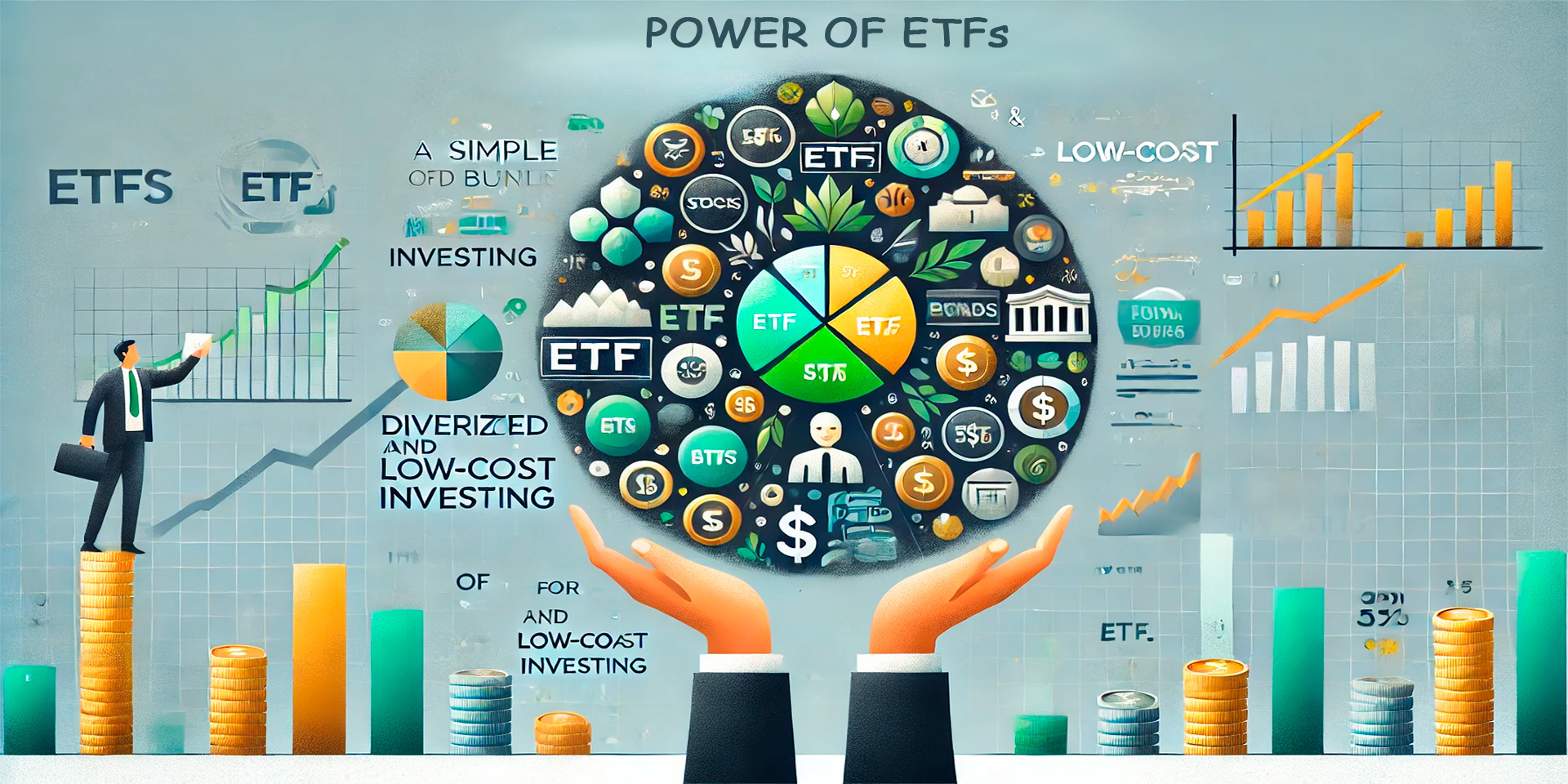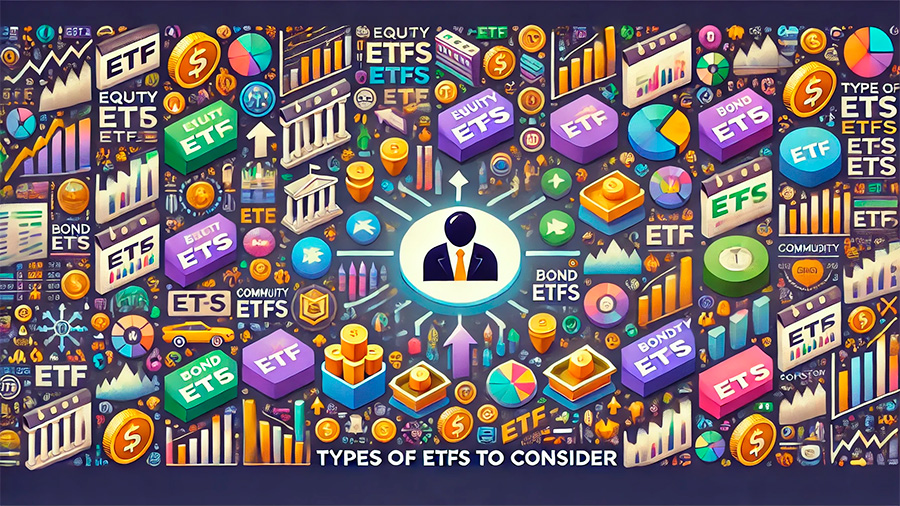
Exchange-Traded Funds (ETFs) are investment funds that hold a collection of assets, such as stocks, bonds, or commodities, and are traded on stock exchanges, similar to individual stocks. When you invest in an ETF, you gain exposure to a broad range of securities within a single fund, making it an easy way to diversify your portfolio. ETFs have become a popular investment choice for ordinary investors because they combine the benefits of diversification, low fees, and flexibility.
How ETFs Work
ETFs are designed to track the performance of a specific index or sector, such as the S&P 500, a particular industry, or even a commodity like gold. Each share of an ETF represents a portion of the holdings within the fund. As the underlying assets increase or decrease in value, the ETF’s price fluctuates accordingly. Investors can buy and sell ETF shares throughout the trading day, just like stocks. ETFs offer a practical way for ordinary investors to access a wide range of markets and asset classes without needing to purchase individual securities.
Why ETFs Are Ideal for Ordinary Investors
ETFs are particularly suited for ordinary investors due to their low cost, ease of use, and ability to provide instant diversification. Whether you’re new to investing or looking for a simple way to build wealth over time, ETFs offer a user-friendly solution that doesn’t require in-depth market knowledge. Here’s why ETFs are considered a smart investment choice:
1. Low Fees and Costs
One of the biggest advantages of ETFs is their low cost structure. Compared to mutual funds, ETFs generally have lower expense ratios, meaning you keep more of your investment returns. The management fees for ETFs are typically less than 0.1% to 0.5%, making them a cost-effective option for long-term investors. Additionally, many brokers now offer commission-free ETF trades, reducing transaction costs and making it easier for investors to build their portfolios without incurring hefty fees.
2. Diversification with a Single Purchase
ETFs provide instant diversification because they contain multiple securities within a single fund. Instead of buying individual stocks or bonds, which can be costly and time-consuming, ETFs allow you to invest in a basket of assets in one transaction. For example, by purchasing an ETF that tracks the S&P 500, you automatically invest in 500 of the largest U.S. companies, spreading your risk across multiple sectors. This built-in diversification reduces the impact of poor performance from any one company, helping to protect your portfolio from volatility.
3. Flexibility and Liquidity
Unlike mutual funds, which are priced only once at the end of the trading day, ETFs can be bought and sold throughout the day at market prices. This flexibility allows investors to react quickly to market conditions and adjust their positions as needed. ETFs are also highly liquid, meaning there’s a large volume of shares being traded, making it easy for investors to enter or exit positions without delays or significant price impacts.
4. Accessibility for New Investors
ETFs are accessible to investors at all experience levels. They are easy to understand and don’t require active management or constant monitoring. With just a small initial investment, you can gain exposure to a diversified portfolio, making ETFs a perfect choice for new investors who want to start building wealth without needing in-depth knowledge of individual stocks or bonds. Many brokers also offer fractional ETF shares, meaning you can invest with even smaller amounts.

Types of ETFs to Consider
There are many different types of ETFs available, each designed to meet specific investment goals. Understanding the various options allows you to choose the right ETFs for your portfolio based on your risk tolerance, time horizon, and financial objectives.
1. Index ETFs
Index ETFs track the performance of a specific market index, such as the S&P 500 or the Nasdaq 100. These ETFs are passively managed, meaning they aim to replicate the performance of the underlying index rather than outperform it. Index ETFs are ideal for investors looking for broad market exposure with minimal fees.
2. Sector ETFs
Sector ETFs focus on specific industries or sectors, such as technology, healthcare, or energy. These ETFs allow you to target high-growth industries or diversify into different areas of the economy. For example, a technology ETF would give you exposure to leading tech companies like Apple, Microsoft, and Google, without needing to invest in each company individually.
3. Bond ETFs
Bond ETFs offer exposure to fixed-income securities, such as government or corporate bonds. These ETFs are often used by investors looking for more stability or income generation. Bond ETFs can help balance a portfolio that’s heavily invested in stocks, reducing overall risk and providing regular interest payments.
4. International ETFs
International ETFs allow investors to diversify their portfolios by gaining exposure to markets outside the U.S. These ETFs invest in foreign companies and provide access to high-growth regions, such as emerging markets in Asia and Latin America. For investors looking to diversify globally, international ETFs offer an easy way to access global markets.

Advantages of ETFs Over Other Investment Options
ETFs offer several key advantages over other popular investment options, such as mutual funds and individual stocks, making them a smart choice for ordinary investors.
1. Lower Management Fees
Compared to actively managed mutual funds, which often charge higher fees due to professional management and active trading, ETFs generally have much lower expense ratios. This means more of your investment returns stay in your pocket, rather than going toward management fees.
2. Tax Efficiency
ETFs are more tax-efficient than mutual funds because they use a process called in-kind creation and redemption, which reduces the frequency of capital gains distributions. This tax efficiency means you’re less likely to incur unexpected tax liabilities, making ETFs an attractive option for tax-conscious investors.
3. Flexibility in Buying and Selling
Unlike mutual funds, which can only be traded at the end of the day, ETFs trade like stocks, allowing you to buy and sell shares during market hours. This gives investors the flexibility to react quickly to market movements, adjust their portfolios, or take advantage of short-term opportunities.
Building a Portfolio with ETFs
ETFs make it easy to build a diversified portfolio tailored to your individual investment goals. By selecting ETFs across different asset classes, sectors, and regions, you can create a balanced portfolio that suits your risk tolerance and time horizon. A well-diversified ETF portfolio might include:
- U.S. Stock ETFs: To gain exposure to large-cap companies in the U.S.
- International ETFs: To diversify globally and capture growth from foreign markets.
- Bond ETFs: To add stability and generate income from fixed-income investments.
- Sector ETFs: To target specific industries or capitalize on high-growth areas like technology or healthcare.
Rebalancing your portfolio periodically ensures that your asset allocation remains aligned with your goals, particularly as market conditions change.
Risks to Consider When Investing in ETFs
While ETFs offer many advantages, it’s essential to understand the risks involved. The value of ETFs can fluctuate, especially in volatile markets, and you may lose money if the underlying securities decline in value. Additionally, some niche or sector ETFs may carry higher risks due to concentration in a specific industry or region. To manage risk, it’s important to diversify across multiple ETFs and avoid putting all your investments in a single sector or asset class.
How to Mitigate ETF Investment Risks
- Diversify: Spread your investments across multiple ETFs to avoid overexposure to any one sector or market.
- Research ETF Holdings: Understand what assets the ETF invests in, especially if you’re focusing on niche or sector ETFs.
- Rebalance Regularly: Review and adjust your portfolio periodically to ensure it remains aligned with your financial goals.
Conclusion: Why ETFs Are a Smart Choice for Ordinary Investors
ETFs offer ordinary investors an accessible, low-cost, and diversified way to build wealth over time. With the ability to invest in a broad range of asset classes and markets, combined with lower fees and tax efficiency, ETFs are an ideal option for anyone looking to grow their investments without the complexities of managing individual stocks or mutual funds. By incorporating ETFs into your investment strategy, you can achieve long-term growth, manage risk effectively, and work towards your financial goals with confidence.
